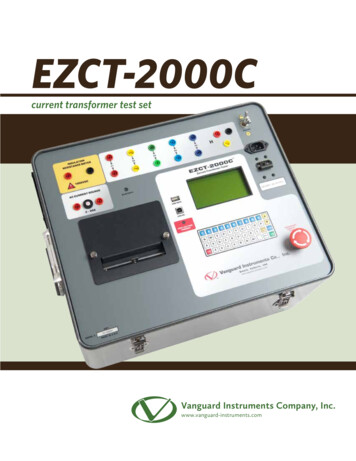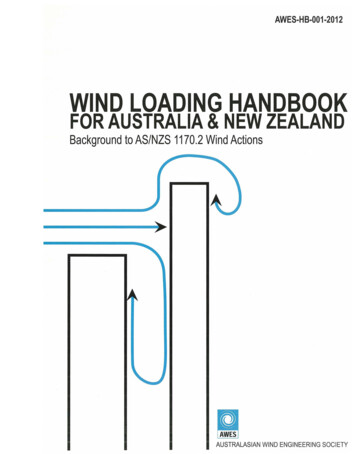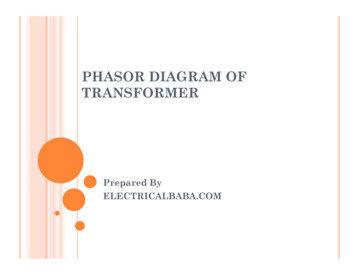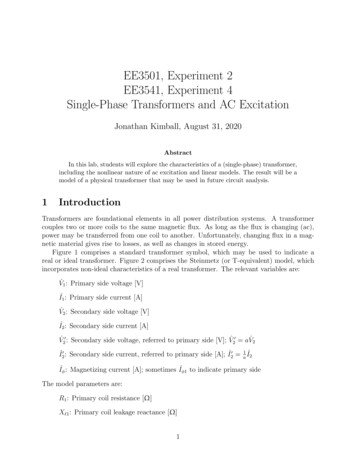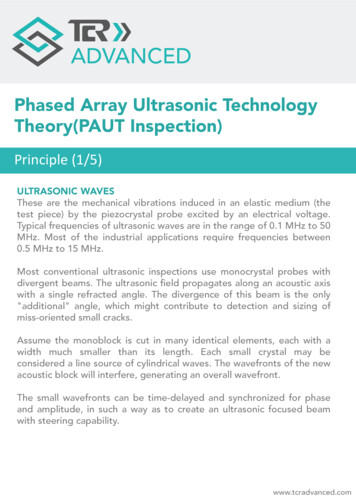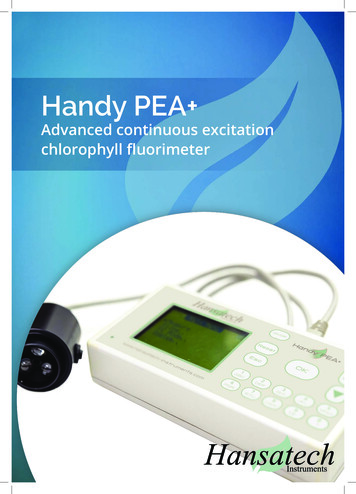
Transcription
Handy PEA Advanced continuous excitationchlorophyll fluorimeter
Handy PEA Advanced continuous excitation chlorophyllfluorimeter Compact (170 x 85 x 40mm), lightweight (565gms) USB2.0 Communications Large-scale screening capacity up to 1000 full trace data files High time resolution detection for discrimination of fastchlorophyll fluorescence induction kinetics Full suite of OJIP analysis parameters (Strasser et al 2000) Saturating high-intensity focused LED array for accuratedetermination of Fm Upload user-defined, repeatable protocols for automatic fieldexecution Interchangeable sensor unit cables with lengths of up to 10metres Powerful Windows data transfer & analysis software included
Handy PEA chlorophyll fluorimeterHandy PEA consists of a compact, light-weightcontrol unit encapsulating sophisticatedelectronics. This provides the high-time resolutionwhich is essential in performing measurements offast chlorophyll fluorescence induction kinetics.Simple to configure and operate, basic measurementfunctionality can be defined directly on the Handy PEA . More complexexperimental design may be acheived using the protocols feature which allows up to5 user-defined protocols to be stored in memory for different field applications. Protocolsare written using a custom Windows software package, PEA (supplied). A tactile keypad allowsselections and inputs to be made and a liquid crystal display module presents menu options and data.The sensor unit consists of an array of 3 ultra-bright red LED’s which are optically filtered to a peak wavelength of650 nm (which is readily absorbed by chlorophyll) at a maximum intensity of up to 3500 µmol m-2 s-1 at the samplesurface. The LED’s are focused via lenses onto the leaf surface to provide uniform illumination over the area ofleaf exposed by the leafclip (4mm dia). An optical feedback circuit monitors and corrects changes in the outputintensity of the LED’s which can be caused by internal heat build-up within the LED’s themselves. The circuit alsocompensates for intensity changes caused by variation in ambient temperature.The sensor unit is fitted with a high-performance pin photodiode. Optical design and filtering ensure that itresponds maximally to the longer wavelength fluorescence signal and blocks the reflected shorter wavelengthLED light used as the source of illumination. Variable rate analysis allows fluorescence signals to be sampled atdifferent acquisition rates throughout the different phases of the induction kinetic. Initially, data is sampled at10 µsecond intervals for the first 300 µseconds with subsequent induction phases analysed at lower acquisitionintervals as the rate of kinetic activity reduces.Up to 1000 recordings of between 0.1 – 300 seconds may be saved in the onboard memory of the Handy PEA .Calculated parameters may be viewed onscreen with more comprehensive data display acheived by transferringsaved data via USB to a PC where the supplied PEA Windows software allows a variety of numerical and graphicalpresentation options.Leafclips and sample dark adaptationContinuous excitation fluorescence systems rely on the use of asuitable leafclip system with 2 functions. Firstly, the leafclip sheildsthe fluorescence detector from ambient light which wouldotherwise “blind” the sensor due to the comparativelyhigh levels of red/infra-red light within thesame waveband as fluorescence itself.Secondly, the leafclip pre-conditions or darkadapts a section of the sample prior to themeasurement.Any measurement of the maximum photochemical efficiency of Photosystem II (Fv/Fm) requires the sample to befully dark adapted prior to measurement. During dark adaptation, all reaction centres within the sample are fullyoxidised making them available for photochemistry and any latent chlorophyll fluorescence yield is quenched. Thisprocess takes a variable amount of time and depends upon plant species, light history prior to the dark transitionand whether or not the plant is stressed. Typically, 15 – 20 minutes may be required to dark adapt effectively.Handy PEA leafclips are constructed from white plastic making them small and lightweight. The locating ring(which interfaces with the Handy PEA sensor) is positioned over the required area of sample and has a central4mm diameter hole which is covered using a shutter plate. During measurement, this shutter slides back toexpose the dark adapted sample to the focussed LED’s and fluorescence detector. A silvered underside reflectsincident light minimising the build-up of heat on the sample and ensuring that the measurement is unaffectedwhen measuring in high ambient light conditions.
Parameters measuredCommon parametersFo - Represents emission by excited chlorophyll amolecules in the antennae structure of Photosystem II.The true Fo level is only observed when the first stableelectron acceptor of Photosystem II called Qa is fullyoxidised. This requires thorough dark adaptation.Fm - The maximum fluorescence value obtained fora continuous light intensity. This parameter may onlybe termed as maximal if the light intensity used isfully saturating and the electron acceptor Qa is fullyreduced.Fv - Indicates the variable component of therecording and relates to the maximum capacity forphotochemical quenching. Calculated by subtractingthe Fo value from the Fm value.Fv/Fm - An indication of the maximum quantum efficiency of Photosystem II and widely considered to be asensitive indication of plant photosynthetic performance.Presented as a ratio between 0 and 1, healthy samples typically achieve a maximum Fv/Fm value of approx. 0.85.Values lower than this will be observed if a sample has been exposed to some type of biotic or abiotic stress factorwhich has reduced the capacity for photochemical quenching within PSII. Fv/Fm is presented as a ratio of variablefluorescence (Fv) over the maximum fluorescence value (Fm).Tfm - Indicates the time at which the maximum fluorescence value (Fm) was reached. May be used to indicatesample stress which causes the Fm to be reached much earlier than expected.Area - The area above the fluorescence curve between Fo and Fm is proportional to the pool size of the electronacceptors Qa on the reducing side of Photosystem II. If electron transfer from the reaction centres to the quinonepool is blocked (such as is the mode of action of the photosynthetically active herbicide DCMU), the area will bedramatically reduced.OJIP analysisPEA software extracts fluorescence values from the recorded dataat 5 pre-defined Time Marks. The times are: T1 50 microseconds T2 100 microseconds T3 (K step) 300 microseconds T4 (J step) 2 milliseconds T5 (I step) 3 millisecondsChlorophyll fluorescence values at these Time Marks are used inconjunction with other measured and calculated values to derive aseries of further biophysical parameters, all referring to time base 0(onset of fluorescence induction).These parameters quantify the photosystem II behaviour forspecific energy fluxes (per reaction centre) for absorption, trapping,dissipation and electron transport in addition to the maximum yieldof primary photochemistry, the efficiency with which a trappedexciton can move an electron into the electron transport chainfurther than QA- and the quantum yield of electron transport.
PEA softwarePEA is a multi-function Windows program supplied with Handy PEA forsystem configuration, data acquisition and post-measurement analysis.Several different data presentation techniques have been combined in orderto effectively demonstrate subtle differences in the fluorescence signature ofsamples which could be indicative of stress factors affecting the photosyntheticefficiency of the plant. Data may be presented in graphical, tabulated or radialplots which can all be tailored to display any number of the 58 parametersmeasured by Handy PEA . Transferred data may be exported to CSV format forfurther statistical analysis in external software packages.PEA allows emhanced configuration of the Handy PEA via the Protocol Editorfeature. Protocols may be defined to include single or multiple measurement assays withoptional pre-illumination periods which can then be uploaded to the memory of Handy PEA viaUSB communications. The use of protocols ensures maximum reproducibility of results during field applicationsinvolving large-scale screening away from a laboratory environment.PEA will run on all supported Microsoft operating systems.System componentsHandy PEA systems are supplied with the following components Handy PEA control unit and sensor HPEA/LC x 2: (20 Leafclips) Mains powered battery charger Protective carry bag USB data transfer cable USB Drive containing PEA software and manuals.Related systemsPocket PEA is designed to be a powerful, effective screening tool capable of performing single flash measurements.Configuration is limited compared with Handy PEA with the only configurable options being measurementduration (1, 3 or 10 seconds) and light intensity (up to 3500 µmol m-2 s-1). M-PEA is a more advanced fluorescencesystem with the added functionality of P700 aborbance and delayed fluorescence capability.
Technical specificationsHandy PEA FluorimeterDimensions:170 (l) x 85 (w) x 40mm (d). Weight: 565gCommunications:USB2.0Operating Conditions:0 - 40oC. Non-condensing humidityBattery:3 x rechargeable Ni-MH 3.6V, 1.8AhrBattery Charger:Integral switch mode charger 8-13.5V input (nominal 12V input)Display:8 line x 20 character LCD displayIllumination:Focused array of ultra-bright red LED’s with NIR short pass cut-off filters. Peak wavelength 650 nm.Spectral-line half width 22 nm.Max. intensity at sample: Up to 3500 μmol m-2 s-1Detector:Fast response PIN photodiode with RG9 long pass filterElectronics:16-bit microprocessor. 12-bit resolution. A/D 10μsec acquisition rate. 8-bit DAC for light control.Real time clockRecord Length:0.1 - 300 secondsMemory:512K battery backed RAM. (Up to 1000 one second duration recordings with full trace data)Leafclips:20 x injection moulded clip system with silvered locating ring, 4mm sample aperture and slidingshutter blade.Partial areas:Parameters measuredFo to Ft1, Ft1 to Ft3, Ft1 to Ft4, Ft1 to Ft5, Ft3 to Ft4, Ft4 toOJIP Data:Ft5, Ft5 to FmtFm, Area, Fo, Fm, FvSlopes & integrals:Normalised data:Fo/Fm, Fv/Fm, Fv/fo, Vj (Fj-Fo)/(Fm-Fo), Vi (Fi-Fo)/(Fm-Fo)Specific fluxes:REo/ETo Δ(Ro), REo/ABS Φ(Ro)Apparent fluxes per CSo:Apparent fluxes per CSm:ABS/RC, DIo/RC, TRo/RC, ETo/RC, REo/RC(ABS/CSm) Fm, DIo/CSm, TRo/CSm, ETo/CSm, REo/CSmPartial performances:Γ(RC)/(1-Γ(RC)), Φ(Po)/(1-Φ(Po)), Ψ(Eo)/(1-Ψ(Eo)), PI(abs),Time marks:Ft1, Ft2, Ft3, Ft4, Ft5Hansatech Instruments isa British company that hasbeen developing high qualityscientific instrumentation forover 40 years. Our systemsare used widely for teaching &research in cellular respiration& photosynthesis programsin more than 100 countriesthroughout the world. We havegained an enviable reputationfor quality, reliability & excellentprice/performance.Yield flux ratios:TRo/ABS Φ(Po), ETo/TRo Ψ(Eo), ETo/ABS Φ(Eo),ABS/RC, DIo/RC, TRo/RC, ETo/RC, REo/RCΔ(Ro)/(1-Δ(Ro))dVg/dto, dV/dto, Sm Area/Fv, N Sm/Ss, Sm/tFmTotal performance, driving force & rates:PI(total), DF(abs), DF(total), kP/ABS * kF, kN/ABS * kFUser parameter:3 User-entered valuesOur product range consists ofa range of modular solutionsfor the measurement of oxygenusing Clark type polarographicsensors. We also developchlorophyll fluorescencemeasurement systems usingboth continuous excitation &pulse-modulated measurementtechniques with furtheroptical instrumentation forthe measurement of samplechlorophyll content.Hansatech Instruments LtdNarborough Road, Pentney, King’s Lynn, Norfolk PE32 1JL, UKTel: 44 (0)1760 338877 Fax: 44 (0)1760 instruments.comPurchasers of HansatechInstruments products can beassured of ongoing support &prompt & efficient attention toenquiries at all times. Supportis available both directly & fromour global distributor network.Customers are encouraged toregister their instruments on ourwebsite which allows access toour Support Ticketing System inaddition to instruments manuals& software upgrades.
our Support Ticketing System in addition to instruments manuals & software upgrades. Technical specifications Handy PEA Fluorimeter Dimensions: 170 (l) x 85 (w) x 40mm (d). Weight: 565g Communications: USB2.0 Operating Conditions: o0 - 40C. Non-condensing humidity Battery: 3 x rechargeable Ni-MH 3.6V, 1.8Ahr
